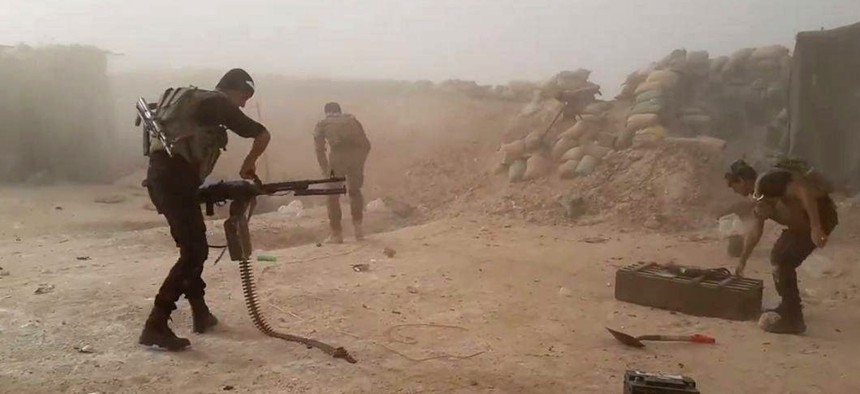
In this image taken Friday, May 29, 2015, Iraqi anti-terrorism forces battle with Islamic State group extremists as they defend their base against Islamic State group extremist attack outside Fallujah. AP Photo
The Iraqi Army No Longer Exists
ISIS’s victory in Ramadi reveals that containment is the best the U.S. can do for now.
The fog of war lies thick over the battlefields of Iraq and Syria. Deliberate enemy deception, willful self-deception, and the complexity of large-scale combat ensure that the truth about war is almost always obscured by a kind of fog. Occasionally a major event parts the clouds and reveals a few fragments of truth, only to have the fog close in again. The collapse of Iraqi defenses in Ramadi is one such event. But we must look quickly to learn anything at all.
The most important fact revealed by ISIS’s victory is that the “Iraqi Army” no longer exists. This is a different observation from that of Secretary of Defense Carter, who avers that they lost the will to fight. Some people did lose the will to fight in Ramadi. But, we should ask a more fundamental question. Ramadi was under siege for months. How is it that few if any reinforcements were sent to defend a city deemed critical to the defense of Baghdad itself? Public sources reported some fourteen divisions in the Iraqi Army in 2014. Between three and five were destroyed in Mosul, leaving nine. At most one was defending Ramadi. Where were the rest? Indeed, where are they now? How is it that Shiite militias must be called upon to liberate Ramadi? If the Iraqi Army has evaporated, or perhaps more accurately deteriorated into a collection of local militias and palace guards, then the U.S. “re-training” mission in Iraq is vastly more difficult than we have been led to believe. Having claimed to build an Iraqi Army, which seems not to exist, and which one doubts ever really existed, the U.S. military is now trying to build another one, from the ground up. Why will things turn out better this time?
ISIS’s victory in Ramadi also reveals that it is quite capable, not merely tactically, but at the “operational level.” Put another way, it is good not merely at fights, which require committed fanatics who are good with a gun, but at campaigns, which require canny commanders, logistical support, coordinated mutually supporting battles, movement, and intelligence. In Ramadi, despite U.S. command of the air, ISIS was able to sustain its forces for many months. They were able to manufacture very large truck bombs, requiring tons of explosives, to support their final offensive. They attacked under the cover of a sandstorm, which helped neutralize U.S. air power.
Finally, in light of ISIS’s success in Ramadi, we must revisit claimed coalition successes such as the fight at the Syrian border town of Kobani, and the “victory” in Tikrit. It was a mystery why ISIS fought so hard for a worthless border town, in the face of waves of U.S. air attacks. In retrospect, one suspects that they were “going to school” on us—spending lives and equipment to learn how to operate in the face of sustained U.S. air attack, which they apparently have figured out how to do. Central Command has claimed that since the campaign began air attacks have killed 8,500 ISIS fighters. These claims seem implausible. The battle of Tikrit, viewed in light of the Ramadi success, now appears as a matador’s cape, a diversionary operation to draw the attention of Iraqi government forces, militias, the Iranians, and the U.S. away from Anbar province and ISIS’s preparations for the attack on Ramadi. Press reports of ISIS casualties in Tikrit do not suggest large losses. Tikrit was well defended, but not heavily defended — an economy-of-force operation, reliant largely on IEDs. If so, the amount of time and energy and collateral damage it required to re-take that town bodes ill for future attacks on places that ISIS might heavily defend, such as Mosul.
(Read more about containment and the fight against ISIS here)
Of course, the fog of war only lifted briefly, and we still cannot see the whole picture, which may be worse, or for that matter, better. But the notion that the Iraqi Army, and the supporting U.S.-led coalition, can soon go on the offensive against ISIS seems a fantasy. If instead, an offensive is launched with the collection of Shia militias that now forms the core of the Iraqi government’s military power, heavily supported by U.S. airstrikes, then we can be sure that any victories they might enjoy will be immensely destructive to the local infrastructure, and will be followed by the most brutal repression of the local Sunni Arab population — not the victory for Iraqi civil society U.S. leaders seek, but rather a guarantee of new waves of recruits for jihad.
What policy therefore ought the U.S. to follow? The ingredients exist in the region for a loose ring of containment around ISIS. That ring strengthens when ISIS pushes into areas populated by other ethnic or religious groups. The U.S. should buck up these defenders with weapons, money, intelligence, and air strikes, when they are under pressure, but should be under no illusions about their capability to defeat ISIS, re-occupy huge swathes of Iraq, and bring those areas into a cohesive Iraqi political community.




